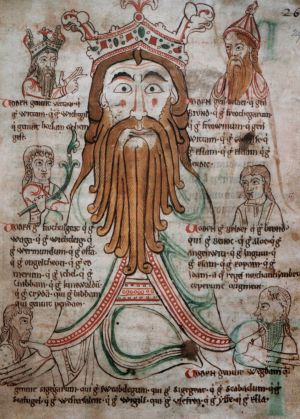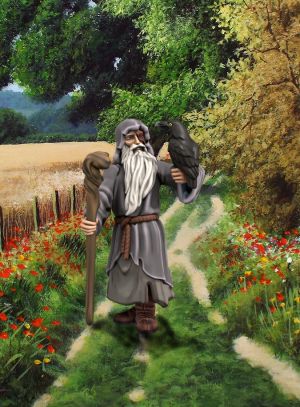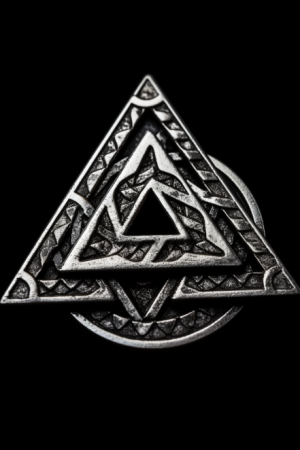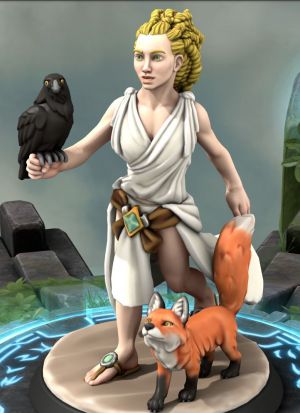Difference between revisions of "Wodenism"
| Line 29: | Line 29: | ||
===Creation=== | ===Creation=== | ||
| − | The primordial being [[Ymir]] became engrossed in a dispute with [[Woden]] in which the god slew him and fashioned [[Otan]] from his flesh. He went on to make the oceans from his blood, the mountains from his bones, trees from his hair, and so forth. [[ | + | The primordial being [[Ymir]] became engrossed in a dispute with [[Woden]] in which the god slew him and fashioned [[Otan]] from his flesh. He went on to make the oceans from his blood, the mountains from his bones, trees from his hair, and so forth. [[Human]]s, [[Ælf]]es, [[Dweorg]]s, [[Grendel]] and the other races were given life from a combination of [[Ymir]]'s flesh and blood (or earth and sea). |
It is perhaps not a coincidence that the primordial being [[Ymir]] is sometimes conflated with the primordial substance [[Ylem]] and many believe that they are one in the same. This conflation adds to the possibility of the creation story being an actual historical account rather than a fantastical metaphor; in the spirit of most religious folk tales. As more in the [[Wodenist|Wodenism]] clergy become familiar with [[Ylem]], this supposition has gained strength with the church. | It is perhaps not a coincidence that the primordial being [[Ymir]] is sometimes conflated with the primordial substance [[Ylem]] and many believe that they are one in the same. This conflation adds to the possibility of the creation story being an actual historical account rather than a fantastical metaphor; in the spirit of most religious folk tales. As more in the [[Wodenist|Wodenism]] clergy become familiar with [[Ylem]], this supposition has gained strength with the church. | ||
Revision as of 08:56, 10 May 2021
| Type | Polytheistic |
|---|---|
| Races | Human, Elf |
| Organized | Yes |
| Founded | 1 IM |
| Books | Book of Woden |
| Deities | Woden, Thor, Frigg, Tiw |
Wodenism is the dominant religion in Otan, with its principal deity being known if not worshipped to some degree by most humans. Wodenism has also found its way into elven culture and figures prominently in their daily lives.
The Tenets of Wodenism

The four pillars of Wodenism are wisdom, strength, love and sacrifice, represented by Woden, Thor, Frigg, Tiw respectively. The Wodenist pantheon has a complete spectrum of gods, however these four remain the personifications of the core values of the faith.
The Book of Woden
Apparently written by Woden himself or someone purporting to be speaking in the voice of Woden, the book outlines the various tenets of Wodenism. It goes on to describe the various gods of the pantheon in stories and verse.
The Will to Power
In the Book of Woden, the three wills are described; the Will to Power, the Will to Perception and the Will to Transcendence. Woden points out that the Will to Power is the greatest of these and is the defining aspect of human(oid) existence. Woden's inclusiveness of other species has made Woden popular among other humanoids, particularly Ælfes.
Wodenist Cosmology
Creation
The primordial being Ymir became engrossed in a dispute with Woden in which the god slew him and fashioned Otan from his flesh. He went on to make the oceans from his blood, the mountains from his bones, trees from his hair, and so forth. Humans, Ælfes, Dweorgs, Grendel and the other races were given life from a combination of Ymir's flesh and blood (or earth and sea).
It is perhaps not a coincidence that the primordial being Ymir is sometimes conflated with the primordial substance Ylem and many believe that they are one in the same. This conflation adds to the possibility of the creation story being an actual historical account rather than a fantastical metaphor; in the spirit of most religious folk tales. As more in the Wodenism clergy become familiar with Ylem, this supposition has gained strength with the church.
Heaven
Afterlife
The Wodenist Pantheon

As in most religions, the Wodenist religion overflows with examples of all four elements of the divine: the creator, the messenger, the intercessor and the destroyer. Apart from the rarity of having a very relatable creator, who also fulfills a role as intercessor, the religion is overflowing with messengers and destroyers; enough destroyers to keep the gods very busy.
The Creator
As creators go, Woden is an unusual one. He created Otan by killing and hollowing out the body of a giant. After this amazing feat he spent the remainder of his days seeking wisdom, fathering humans and routinely interacting with them on a very personal level. Particularly in the northern Soltustik tribes, it is not unusual for individuals to claim their lineage from Woden himself. Of his many names, the All-Father is perhaps the one most suited to him.
The role of the creator is filled solely by:
- Woden: God of Wisdom, the All-Father
The Intercessors
The gods of the Wodenist religion have interactions with humans regularly... if the humans themselves are exceptional. The gods will sit at table and eat and drink with humans who excel in some aspect of physical prowess or cognitive genius. They will intercede while engaged in this intimate dialogue to protect their human guests from, for example, a mischievous giant. It would be very rare, however, for them to take direct action in a human affair, such as intervening in a battle. In the latter case the gods will rather send a messenger, a Valkyrie, to tell the slain human how he did.
The role of the intercessor is fulfulled by the following gods and goddesses:
- Thor: God of Strength, Thunder and Lightning
- Frigg: Goddess of Love, the Hearth and Home
- Tiw: God of Sacrifice and War
- Baeldaeg: God of Bravery and Light
- Eostre: Goddess of Fertility
The Messengers
The Destroyer
All things must end, and for Wodenists this time is Ragnarok. Otan will one day be consumed in flames and the malevolent creatures who bring about this destruction are none other than the offspring of Loki.
The role of the destroyer is fulfilled by:
- Loki: God of Mischief
- Fenris: A Very Large Wolf
- Hel: Goddess of the Underworld
- Jormungandr: A Very Large Snake
The Wodenist Clergy
There are two principal types of Wodenist clergy. The itinerant and the stationary. The stationary tend to practice their faith and devotions at the a chapter of the Temple of Woden. The itinerant tend to serve in the military or with bands of adventurers seeking fame and fortune while spreading the will of Woden to the world.
The Temple of Woden
The Temple of Woden is a loosely organized bureaucracy that is dedicated to building edifices throughout Otan to support the worship of Woden and other gods in the Wodenist pantheon. A temple can be found in nearly every major city in northern Otan.
Temple Activities
Since the beginning of time, Wodenist priests have strived to create the fabled Nine Herbs Charm. This charm is said to bring additional power and veneration upon the creator and invoker of the charm.
The Temple has also been actively involved in expansionist measures, encouraging its clerics to spread the word of Woden to other nations and peoples.
Religious Observances
- 30th of Jeltoskan - the Night of the Wild Hunt, where Woden and his fellow gods set out to hunt for the feasts of
- 1st to 6th of Holy Week - Yule, which continues all the days throughout Holy Week.
Popular Folklore
| Copyright © 2021-2024 by Robyn Blaber and Will to Power Games. All rights reserved. Content on this website may not be reproduced without written permission of the copyright owner. |


